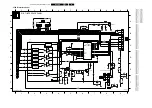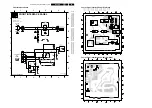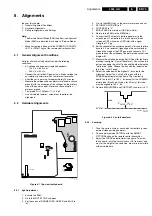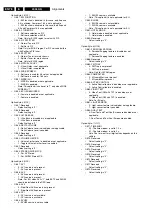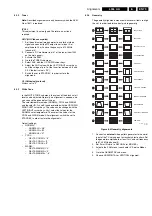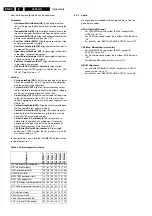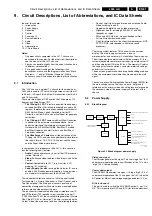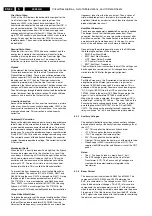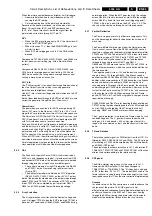
Circuit Descriptions, List of Abbreviations, and IC Data Sheets
9.
9.2.3
Startup Sequence
When the set is connected to the AC power, the rectified line
voltage (via winding 4-5 of L5531 connected to pin 14 of
IC7531) will start the internal voltage source to charge the V_cc
capacitor (C2532). The IC starts to switch as soon as the V_cc
reaches the V_cc start level of 9.5 V. This supply is
automatically taken over by winding 1-2, as soon as the V_cc
is high enough, and the internal supply source will stop (for high
efficiency switching).
Table 9-1 Pinning overview TEA1523
As C2532 of IC7531 is charged, it will also start to charge the
V_cc capacitor (C2511) of IC7511. Via resistor R3519 and
C2511, the TEA1506 starts to switch as soon as the V_cc
voltage reaches the V_cc start level of is about 11 V. The V_cc
voltage is automatically taken over by the main transformer
L5512 (winding 2-3) when the V_cc is high enough (when this
voltage is even higher than the voltage on C2511, there is no
current flow from C2532 to C2511 due to diode D6512).
Table 9-2 Pinning overview TEA1506
9.2.4
Standby Mode
In this mode, IC7511 (TEA1506) will be totally disabled. So
there is no voltage on the main transformer output. But IC7531
(TEA1523) will still work and will provide the necessary output
voltages (6V -> 5V, 3.3V, 3V -> 1.8V) to the Hercules (IC7200).
Table 9-3 PSU voltage overview
9.3
Deflection
9.3.1
Synchronization
Before the Hercules (IC7200) can generate horizontal drive
pulses, the +3.3V supply voltages must be present. After the
start up command of the microprocessor (via I2C), the
Hercules outputs the horizontal pulses. These horizontal
pulses begin “initially” with double line frequency and then
change “gradually” to line frequency in order to limit the current
in the line stage (slow-start).
The VDRA and VDRB signals are the balanced output currents
(sawtooth shaped) of the frame oscillator (pins 106 and 107 of
the Hercules). These output signals are balanced, so they are
less sensitive to disturbances.
There is a current source inside the UOC at pin 102. This
pumps energy in the capacitor connected to this pin producing
a pure saw tooth. The vertical drive signals and the E/W
correction signal are derived.
Pin 108 is the East-West drive (or AVL), and it is a single ended
current output. The correction for “horizontal width for changed
EHT” from this pin is available by setting the HCO bit to “1”.
The Phase-2 Compensation available at pin 113 gives frame
correction for high beam currents. The phase compensation
signal is used to correct the phase of the picture from the
horizontal drive signal.
Pin 63 is the SANDCASTLE output (contains all sync info) and
also HORIZONTAL FLYBACK (HFB) input.
Pin 97 is the EHT tracking/over-voltage protection pin. The
HCO bit can switch on the tracking on EW. If the voltage at pin
97 exceeds 3.9 V, the over-voltage protection will be activated
and the horizontal drive is switched “off” via a slow stop.
9.3.2
Horizontal Deflection
There are several executions (depending on the CRT):
•
Sets with no East-West correction. The principle of the
horizontal deflection is based on the quasi-diode
modulation circuit. This horizontal deflection circuit
supplies the deflection current and auxiliary voltages from
the LOT.
•
Sets with East-West correction. The principle of the
horizontal deflection is based on a diode modulator with
east-west correction. This horizontal deflection circuit
supplies the deflection current and auxiliary voltages from
the LOT.
•
Sets with dynamic East-West correction. The principle
of the horizontal deflection is based on a diode modulator
with dynamic east-west correction for picture tubes with
inner pincushion. This horizontal deflection circuit supplies
the deflection current and auxiliary voltages from the LOT.
Basic Principle
During a scan period, either the Line Transistor or diode(s)
conduct to ensure a constant voltage over the deflection coil
(that results in a linear current). During the flyback period, the
Line Transistor stops conducting, and the flyback capacitor(s)
together with the inductance of the deflection coil creates
oscillation.
Pin
Symbol
Description
2
Gnd
This pin is Ground of the IC.
3
V_cc
This pin is connected to the supply voltage. An internal current
charges the V_cc capacitor (2532), and the start-up sequence
is initiated when this voltage reaches a level of 9.5 V. Note: The
output power is disabled when the voltage gets below 9 V
(UVLO). Operating range is between 0 to 40 V.
5
RC
Frequency setting
6
REG
This pin is connected to the feedback loop. The pin contains two
functions: 1) Between 1 to 1.425 V it controls the "on" time. 2)
Above the threshold of 3.5 V, it is possible to initiate "burst
mode" standby.
11
Demag
This pin is connected to the V_cc winding of 5531. It has three
functions: 1) During Magnetisation, the input voltage is sensed
to compensate OCP level for OPP. 2) During demagnetisation,
the output voltage is sensed for OVP and 3) A comparator is
used to prevent continuous conduction when output is
overloaded.
12
Sense
This pin contains three different functions.: 1) Dectection of soft
start, protection levels of 2) OCP, and 3) SWP.
14
Drain
This pin is connected to the drain of the switch or center tap of
the transformer. It contains three functions: 1) M-level (mains-
dependent operation-enabling level), 2) Supply for start-up
current, and 3) Valley detection.
Pin
Symbol
Description
2
Vcc
This pin is connected to the supply voltage. When this voltage
is high (Vcc_start level, about 11 V), the IC will start switching.
When the voltage is lower than Vcc_uvlo (about 8.7 V), the IC
will stop switching.Note: This pin is not self supplied by internal
source like in TEA1507
3
Gnd
This pin is Ground of the IC.
6
Ctrl
This pin is connected to the feedback loop. The pin will control
the "on" time between 1 V to 1.5 V.
7
Demag
This pin is connected to the Vcc winding of 5512. It contains
three functions: 1) During magnetisation, the input voltage is
sensed to compensate OCP level for OPP, 2) During
demagnetisation, the output voltage is sensed for OVP and 3)
a comparator is used to prevent continuous conduction when
the output is overloaded.
9
Sense
This pin contains three different functions: 1) dectection of soft
start, protection levels of 2) OCP, and 3) SWP.
11
Driver
This pin will drive the (MOSFET) switch.
12
HVS
This is High Volt Spacer (n.a.)
14
Drain
Connected to the Drain of the external MOSFET switch, this is
the input for valley sensing and initial internal supply.
Voltage
Normal operation
Stdby mode
V_batt
130 - 143 V
0 V
V_audio
+/- 15.5 V
0 V
+6V
6 V
6 V
+3V
3 V
3 V
Stdby_con
0 V
3.3 V
Summary of Contents for L04LAA
Page 36: ...Service Modes Error Codes and Fault Finding EN 36 L04L AA 5 E_06532_012 eps 130204 ...
Page 58: ...58 L04L AA 7 Circuit Diagrams and PWB Layouts Layout Mono Carrier Part 1 Bottom Side Part 1 ...
Page 93: ...Spare Parts List EN 93 L04L AA 10 10 Spare Parts List Not applicable ...
Page 94: ...Revision List EN 94 L04L AA 11 11 Revision List First release ...


